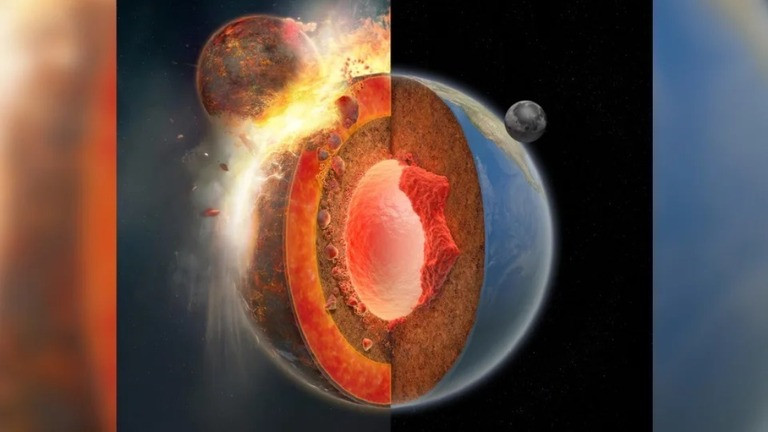地球に衝突した惑星「テイア」の残骸発見か、月の形成に寄与 新研究

New research finds debris from planet Theia that collided with Earth, contributing to moon formation

New research finds debris from planet Theia that collided with Earth, contributing to moon formation
数十億年前に地球が形成される際、太古の惑星が衝突して破片が飛び散り、その破片が合体して現在の夜空を彩る月になった――

When the Earth was forming billions of years ago, ancient planets collided and scattered fragments, which coalesced to form the moon that colors the night sky today.

When the Earth was forming billions of years ago, ancient planets collided and scattered fragments, which coalesced to form the moon that colors the night sky today.
この点について大方の科学者の見解は一致している

Most scientists agree on this point

Most scientists agree on this point
この理論は「ジャイアント・インパクト仮説」と呼ばれ、月と地球の基本的な特徴の多くを説明している

This theory is called the ”giant impact hypothesis” and explains many of the fundamental features of the moon and Earth.

This theory is called the ”giant impact hypothesis” and explains many of the fundamental features of the moon and Earth.
だが、地球に衝突したとされる惑星「テイア」の存在については、これまで直接の証拠をつかめていなかった

However, until now, no direct evidence has been found regarding the existence of the planet Theia, which is said to have collided with Earth.

However, until now, no direct evidence has been found regarding the existence of the planet Theia, which is said to have collided with Earth.
太陽系内でテイアの破片は見つかっておらず、科学者の間では、テイアが地球に残した残骸は地球内部の高温部で溶解したとの見方が多かった

No fragments of Theia have been found in the solar system, and scientists have assumed that the remains of Theia left behind on Earth melted in the hot interior of Earth.

No fragments of Theia have been found in the solar system, and scientists have assumed that the remains of Theia left behind on Earth melted in the hot interior of Earth.
しかし、テイアの残骸は部分的に残っており、地球内部に埋まっていると示唆する新理論が登場した

However, a new theory has emerged that suggests some of Theia’s remains remain, buried deep inside the Earth.

However, a new theory has emerged that suggests some of Theia’s remains remain, buried deep inside the Earth.
科学誌ネイチャーに1日付で発表された研究によると、地球に衝突後、テイアの溶けた塊はマントルの中に沈み込んで固体化した

After impacting Earth, Theia’s molten mass sank into the mantle and solidified, according to a study published in the journal Nature on Wednesday.

After impacting Earth, Theia’s molten mass sank into the mantle and solidified, according to a study published in the journal Nature on Wednesday.
その結果、テイアを構成する物質の一部が地球の核の上方、地下約2900キロの位置に残ったという

As a result, some of the material that made up Theia remained above the Earth’s core, about 2,900 kilometers underground.

As a result, some of the material that made up Theia remained above the Earth’s core, about 2,900 kilometers underground.
